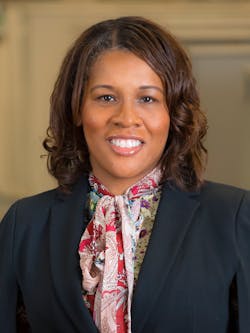Q&A: Murielle Beene, Chief Health Informatics Officer at Trinity Health
To address the nursing workforce crisis, nonprofit Trinity Health, which has 88 hospitals across 26 states, has rolled out a new delivery model to 38 nursing units in their hospitals in eight states. Trinity’s Virtual Connected Care approach uses virtual nurses to support direct care staff and increase patient interaction.
Experienced as a registered nurse herself, Murielle Beene, senior vice president and chief health informatics officer at Trinity Health, recently spoke with Healthcare Innovation about the new model. She oversees a team of about 500 health informatics professionals, helps provide strategic guidance and decision-making on how the organization invests in health information technology, how they use it, and how they partner with other organizations on initiatives. Their full implementation timeline for Virtual Connected Care extends into the early part of next year, she said.
HCI: Can you describe how this new model works?
Beene: In our three-person care team model, patients are treated by a direct care nurse, an on-site certified nursing assistant or LPN, and a nurse who remotes into the patient’s room virtually. The virtual nurse is also a registered nurse. The virtual nurse has a one-to-many relationship with a few care teams. That right dose of nursing is what we are focused on, when we think about how we engage, how we are trying to give the nurses back their time, at the bedside, and trying to provide the virtual nurse with some of those activities that could help offset some of the activities that the bedside nurse would engage in.
HCI: Does the virtual nurse engage with the patient? Or do they just engage with the other nurses on site? And is there a video camera involved?
Beene: There's a camera in the room and the virtual nurse engages not only with the patient but also with that bedside nurse. Through other modalities within our processes and workflows, that bedside nurse and virtual nurse remain in contact and constant communication.
HCI: You mentioned that the virtual nurse could take some of the load off of the in-person nurses to free up some of their time. What are some of the activities that that virtual nurse can do from afar?
Beene: Admission assessments is a huge time saver. With the technology that we're using, the virtual nurse is able to not only help to take the documentation in the electronic health record, but also able to pan, tilt and zoom into the room, and can communicate with the patient as well. And what our patients love is that now there's someone who they can ask questions of, without having to wait. They don’t have that experience of being in the bed, pressing a button and no one coming. The virtual nurse is much more responsive to their questions.
HCI: Have other health systems deployed a similar model previously? Or do you feel like Trinity is pioneering this?
Beene: Each of the healthcare systems has a different way they're defining this. What makes us unique is that we have a care team model. It's not just one task or one activity that is virtual. They're not separate activities. For example, we know of a healthcare system where what their virtual nurse does is discharge activities, and that's all they do. That is one of the activities that virtual nurses can do in our model, but it's not the only one.
HCI: Any anecdotal feedback yet from the nurses participating?
Beene: One positive thing that we've heard over and over is that the nurses, especially some of our newer nurses, like the mentoring aspects. The virtual nurse also can serve as a mentor. We think the ideal person for this role is an experienced nurse who wants a less physically demanding role. That person may be near the end of their career. So mentoring is one of the areas where people feel that satisfaction. This is a novel model, so it does require a different way of thinking of how we think of doses of nursing. They're working on it and they're learning. We are getting more positive feedback.
HCI: Any other things that you want to mention about this initiative that we haven't that I haven't asked about, or the that you'd want to stress?
Beene: One thing I do really want to stress is that if we try to apply old thinking to a new problem, we're going to still end up in the same place. I truly believe that. We do need to make space for innovation. This is the only way through. We’ve got to understand that we are in a crisis. And we have to make space for technologies or different ways of thinking to permeate the space so we can get to another place.
The other thing that I would also like to mention is not to underestimate the change aspect of these types of models. I can’t even quantify the investment that goes into change. Our chief nursing officers are helping us to lead these efforts locally. There are some nurses who think that this is a pet project or this is not real, or this is something that's going away. This is not going away. We have to figure this out together. We definitely have to make space for these types of innovations. Because we won't be able to move forward without it.


